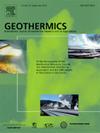Survey and observation of earthquake swarm and buried geothermal resources by seismological analyses, seismic tomography, magnetotelluric, and gravity modeling of the upper crustal structure of the Yalova-Termal Region
IF 3.9
2区 工程技术
Q3 ENERGY & FUELS
引用次数: 0
Abstract
This study presents the results of various geophysical methods applied in and around a thermal source in Yalova, Türkiye. Termal town, located on the seismically active Armutlu Peninsula, is the focus of the investigation. The research explores earthquake swarms and their relationship with hydrothermal activity in the area. The findings are compared using seismological analyses and different geophysical techniques, including seismic tomography, magnetotelluric (MT), and gravity surveys. A previously unrecognized boundary of the geothermal source was identified using 3D resistivity models derived from MT data, corroborated by the location of an existing well. Key observations include a high density of earthquake events, sharp variations in seismic tomography parameters (Vp, Vs, and Vp/Vs ratio) particularly along fault zones, as well as high-resistivity and negative Bouguer gravity anomalies in and around Termal town. Despite differences in resolution among the three geophysical methods, their results were consistent and complementary. The MT and gravity data show comparable features down to approximately 1 km depth. While exact comparisons at shallow depths are limited, the anomalies identified in the seismic tomography appear to extend from those observed in the MT and gravity datasets.
利用地震分析、地震层析成像、大地电磁、重力模拟等方法对亚洛瓦断裂带上部地壳结构的地震群和埋藏地热资源进行调查与观测
本研究介绍了应用于俄罗斯kiye Yalova一个热源及其周围的各种地球物理方法的结果。Termal镇位于地震活跃的阿穆特鲁半岛,是此次调查的重点。该研究探讨了地震群及其与该地区热液活动的关系。利用地震学分析和不同的地球物理技术,包括地震层析成像、大地电磁(MT)和重力测量,对这些发现进行了比较。利用MT数据导出的三维电阻率模型确定了以前未被识别的地热源边界,并得到了现有井位置的证实。主要观测包括高密度地震事件,地震层析成像参数(Vp, Vs和Vp/Vs比)的急剧变化,特别是沿断裂带,以及Termal镇及其周围的高电阻率和负布格重力异常。尽管三种地球物理方法在分辨率上存在差异,但它们的结果是一致和互补的。MT和重力数据在深度约1公里处显示出类似的特征。虽然在浅层深度的精确比较是有限的,但在地震层析成像中发现的异常似乎是从MT和重力数据集中观察到的。
本文章由计算机程序翻译,如有差异,请以英文原文为准。
求助全文
约1分钟内获得全文
求助全文
来源期刊

Geothermics
工程技术-地球科学综合
CiteScore
7.70
自引率
15.40%
发文量
237
审稿时长
4.5 months
期刊介绍:
Geothermics is an international journal devoted to the research and development of geothermal energy. The International Board of Editors of Geothermics, which comprises specialists in the various aspects of geothermal resources, exploration and development, guarantees the balanced, comprehensive view of scientific and technological developments in this promising energy field.
It promulgates the state of the art and science of geothermal energy, its exploration and exploitation through a regular exchange of information from all parts of the world. The journal publishes articles dealing with the theory, exploration techniques and all aspects of the utilization of geothermal resources. Geothermics serves as the scientific house, or exchange medium, through which the growing community of geothermal specialists can provide and receive information.
 求助内容:
求助内容: 应助结果提醒方式:
应助结果提醒方式:


